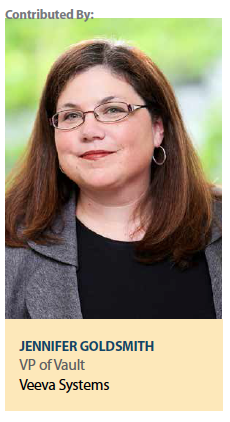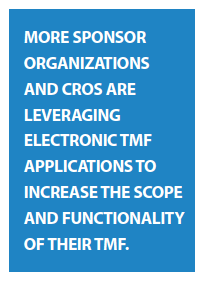 On April 2014, the UK’s Medicines & Healthcare Products Regulatory Agency (MHRA) updated its definition of a critical GCP inspection finding to include trial master files (TMFs) that were “not readily available or accessible." The agency asserted the change was partly driven by the fact that more than one-third of TMF inspections are delayed due to incomplete or inaccessible files. In response, the global life-sciences industry heightened its focus on managing its TMF content compliantly as part of a larger movement from paper to fully electronic trial master files (eTMFs).
On April 2014, the UK’s Medicines & Healthcare Products Regulatory Agency (MHRA) updated its definition of a critical GCP inspection finding to include trial master files (TMFs) that were “not readily available or accessible." The agency asserted the change was partly driven by the fact that more than one-third of TMF inspections are delayed due to incomplete or inaccessible files. In response, the global life-sciences industry heightened its focus on managing its TMF content compliantly as part of a larger movement from paper to fully electronic trial master files (eTMFs).
While the motivation driving the move toward eTMFs was undisputable, the technology landscape at the time was not structured to support increased regulatory and changing business models. Since then, some technology providers have addressed these challenges by evolving the eTMF from a static, end-of-lifecycle archive repository into an active, in-process, accessible solution. A year out from the MHRA update, the industry is starting to make progress. More sponsor organizations and CROs are leveraging eTMF applications to increase the scope and functionality of their TMF.
12 Months of Transition
While companies have started to make the move to next-generation eTMF solutions, variances in the design and sophistication of early systems help explain the MHRA’s assertion that many TMFs failed to meet inspectors’ expectations for accessibility and completeness.
When Veeva Systems surveyed more than 250 TMF owners last spring in the largest eTMF survey to date, it found that over half of the organizations using eTMFs reported working with either a local file share system (26%), or a cloud file share such as an FTP site or dropbox.com (18%). More than one-third of respondents reported using generic content management systems like EMC Documentum or Microsoft SharePoint to store and share clinical trial documents, whereas only 13% had implemented a life sciences-specific eTMF.
According to Franciska Darmer, former auditor with a global drug maker and who recently joined Veeva, early versions of eTMF systems were little more than electronic filing cabinets. “Local file shares and FTP sites were the go-to choice for many early adopters.
Unfortunately, these systems lacked robust functionality, failed to process the vast volumes of documentation associated with a clinical trial, and did not meet the accessibility requirements of the inspection process."
 Sponsors that replaced paper TMF files with such local network file shares did not foresee the resulting reporting and quality control challenges. For example, one of the biggest challenges is that these systems often serve as a company’s central repository for all clinical trial documents and data globally. Lacking any significant form of configurable security, these systems made all trial documentation visible without restriction, forcing sponsors to create mirror files containing just the relevant documents for inspectors. Even with this mirroring, inspectors often still had to wade through unrelated trial data.
Sponsors that replaced paper TMF files with such local network file shares did not foresee the resulting reporting and quality control challenges. For example, one of the biggest challenges is that these systems often serve as a company’s central repository for all clinical trial documents and data globally. Lacking any significant form of configurable security, these systems made all trial documentation visible without restriction, forcing sponsors to create mirror files containing just the relevant documents for inspectors. Even with this mirroring, inspectors often still had to wade through unrelated trial data.
“To be inspection ready, sponsors must be able to quickly organize all documents related to the trial, and make them easily accessible to inspectors," Darmer continued. “In cases where sponsors didn’t consider the external usability of their eTMF, inspectors were forced to navigate cumbersome filing systems and thousands of unrelated documents, plus could not access trial documents in real time."
The Next Evolution
To improve the inspection process, sponsors and CROs have begun moving to purpose-built, cloud eTMF solutions. In fact, five of the world’s largest drug makers and half of the leading CROs now rely on next-generation systems to meet four key requirements:
1. Continual inspection-readiness and unlimited accessibility. Without robust functionality, early eTMFs had no built-in controls and document review only occurred at study end. Today’s eTMFs automate workflows to ensure SOP adherence at all times plus provide robust reporting for deeper insights into trial activity. Additionally, many enable easy remote access for inspectors and auditors so documents can be reviewed as necessary from anywhere at any time.
2. Comprehensive trial documentation, with no incomplete or missing documents. Quality control challenges drove many of the MHRA’s frustrations with early eTMFs. Documents were often stored in multiple repositories and in different formats with little version control. Purpose-built eTMFs today enable a single source of truth across all parties to ensure all documents are up to date and in one location.
3. Easy navigation with intuitive user interfaces. Regulatory agencies typically recommend that their inspectors should be able to navigate a sponsor’s eTMF after no more than one hour of training. However, it was often taking frustrated inspectors days to dig through complicated systems and irrelevant documentation. A familiar, consumer web-like user interface allows for quick training and navigation as simple as shopping online.
4. Rich insights to improve operational efficiency. Simple file shares and generic content management systems are unable to provide critical insight into the clinical development process. Purpose-built eTMF systems, in contrast, capture process- and quality-specific data.
Real-time reporting leverage this information to provide organizations with an in-process view of the trial.
Nigel Jones, VP of Global Clinical Development at TFS, a full-service CRO, believes the simplicity and accessibility of cloud-based eTMF systems have become a pre-requisite for doing business with global drug makers. “The majority of proposals CROs submit today include some form of eTMF support," he said.
“We invested in a robust, accessible eTMF solution to support our expansion across continents, and have since realized the cost and time savings that come from a streamlined, automated system for sharing and storing all trial documents," Jones continued. “In the past, our project managers could spend weeks working with a client to prepare the TMF for inspection. Now our researchers use the time they used to spend chasing documents to act on trial data, rather than just collect it."
Many first-generation eTMFs were built around “electronic filing cabinets" that still retained paper-based processes, such as printing and scanning documents. Consequently, sponsors, CROs and inspectors found these early systems did not deliver the benefits of a truly paperless TMF. “The entire trial process is rapidly moving away from paper," Jones observed. “Today the majority of clinical trials are done with electronic data capture to save the data entry step and enable the collection of important trial performance data."
To support the paperless model, next-generation eTMF systems offer electronic processes for information sharing and storage. Individuals no longer send paper to a central records management team. Rather, the responsibility for filing documents into the eTMF is distributed across the clinical ecosystem, making it critically important to assign and communicate ownership of TMF documents. When all parties have defined roles in the study SOPs, sending files electronically and ensuring task completion is quick and efficient.
In particular, cloud-based solutions are well-suited to support this type of paperless environment as they offer the highest level of collaboration across a diverse set of participants. Sponsors ensure consistency and adherence to process controls by creating documents directly in the eTMF system. With multiple parties submitting information to the TMF remotely throughout the lifecycle of the trial, automated standards are in place to ensure quality up front. Missing documents are brought to sponsors’ attention throughout the trial, and incomplete documentation is identified early in the process and sent back to the study team for immediate correction. The result is a TMF that is always inspection ready.
Renee Fate, a senior manager responsible for document management at Kythera Biopharmaceuticals, a clinical-stage biopharmaceutical company, said its new eTMF system provided the rapidly growing company with a single platform on which to collaborate with partners efficiently and ensure inspection readiness at all times. “Since adopting a cloud eTMF, we’ve been able to shave at least 40% off the time needed to reconcile TMF documents at the conclusion of a trial. Now, we have full visibility and can track the status of the TMF in real time for the entire duration of the study," Fate said.
Even before the MHRA issued its guidance to simplify eTMF navigation, one of the biggest challenges that sponsors and CROs faced when implementing an eTMF was getting people to use it. Typically, eTMF and content management systems proved overly complex and cumbersome to navigate. Over the last year, more sponsors have started implementing improved eTMF systems with simplified operations to satisfy inspectors’ ease-of-use requirements.
Now, using an eTMF is becoming a natural part of the clinical trial process workflow, ensuring study findings are reported as they happen and status reporting is more accurate and effortless. Real-time insight into trial progress allows the entire team to finally collect data throughout studies, and use that data to make better decisions about commercial strategy and therapy effectiveness. Over time, data-driven trial optimization will result in more efficient trials and faster time to market.
Some forward-thinking organizations are already unlocking the benefits of TMF metrics. In the Veeva 2014 eTMF survey, the companies that reported extensive use of performance data saw markedly more benefits from their eTMF systems than those that did not collect metrics. For example, these organizations noted improved document quality (63% versus 29%); greater audit and inspection-readiness (56% versus 25%); easier collaboration with sites (54% versus 32%); and, increased SOP compliance (49% versus 16%).
Kythera’s eTMF solution now allows the internal auditor to regularly run a full range of standard and ad hoc reports, giving a more accurate view of trial progress. According to Fate, “When everyone has visibility into the reports, it removes a lot of questions at meetings and with our CRO. We are all spending less time meeting and more time working."
Automated filing and accessible data sharing systems mean that internal auditors have the opportunity to redefine their role and do more with less. Cloud eTMF solutions allow auditors to manage the quality of a TMF remotely and in real time, ensuring compliance without the need to visit multiple sites and spend weeks at a time on the road.
“In the past, our auditors were used to enduring a 48-hour-or longer wait for a box to arrive from off-site storage, only to find that it didn’t contain the desired document," Fate described. “Today, the correct documents are retrieved in seconds. With our cloud eTMF, my audit teams are travelling less, and spending more time ensuring quality and analyzing trial effectiveness."
New Reporting Guidelines Drive Life Sciences Forward
Sponsors, CROs, and health authority inspectors all have similar goals: to be able to access the TMF easily, whenever and from wherever they are. Cloud technology provides this type of ubiquitous access, but when also linked innately to clinical processes, the TMF becomes more than just an electronic record. Fully unlocked, next-generation eTMF solutions can be strategic assets that not only dramatically improve the inspection process, but also offer sponsors the type of insights within and across trials that drive long-term improvement for clinical programs.
The industry has had a year to digest the MHRA’s updated definition of a critical GCP inspection finding as it relates to the TMF, pushing a growing majority of companies to adopt operational and technology strategies to meet or even exceed the MHRA’s expectations. The switch to solutions that support global compliance, as well as improve overall study efficiency and effectiveness is likely to continue not just to meet health authority requirements, but also to bring potentially life-saving products to market faster. The success these pioneering organizations are achieving could have a significant impact large influence on the shape of study management and the clinical technology landscape for years to come. (PV)
Editor’s Note: To download the Veeva 2014 Paperless TMF Survey: An Industry Benchmark, October 7, 2014, visit http://www.veeva.com/tmf-survey-2014.
Veeva Systems Inc. is a leader in cloud-based software for the global life sciences industry. Committed to innovation, product excellence, and customer success, Veeva has more than 275 customers, ranging from the world’s largest pharmaceutical companies to emerging biotechs. Veeva is headquartered in the San Francisco Bay Area, with offices in Europe, Asia, and Latin America.
For more information, visit veeva.com.
















